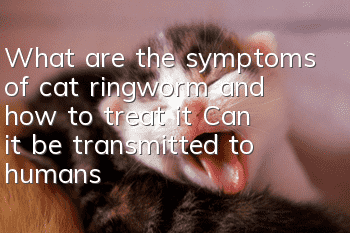The “cat plague” that makes people’s faces change after hearing about it

Originally, the term feline plague had been almost forgotten by people. Unexpectedly, feline plague outbreaks have occurred in Taiwan in recent years, causing many owners to pay attention to this terrible cat disease again. But prevention is better than cure, so let the editor help all owners to get to know this enemy called "cat plague" and repel it.
【Unveiling the mystery of cat plague】:
Feline distemper, actually the common name of "Feline panleukopenia" and "Feline infectious enteritis", is a viral disease caused by "feline parvovirus". The fatality rate is extremely high and it is the number one enemy of cats and their owners. This small feline virus will inhibit the hematopoietic cells in the bone marrow, causing the number of white blood cells to drop sharply, and eventually lead to death due to dehydration and excessive blood loss due to insufficient white blood cells and hemorrhagic enteritis. Feline plague is very common among cats and can be transmitted to all cats and raccoons. It is highly contagious and its combat power should not be underestimated.
【Attack strategy of cat plague】:
Generally, infection is mainly through contact, but it can also be transmitted through blood-sucking insects or fleas, or through contact with contaminated environments. Feline distemper is mainly active in wild cats and kittens that have not received vaccinations. They are infected through contact between cats and cats and contaminated environments; if the environment is contaminated by feline distemper, the virus will can be contagious for several years. The source of infection mainly comes from cat excrement, saliva, and vomitus during the acute infection period. Although cat plague is more likely to occur in young cats, cats of other ages are also at risk, especially the birth season of cats, which is the peak period of infection.
Although the fatality rate of cat plague is extremely high, there is still a possibility of survival. After the sick cat recovers, it will still remove the toxins from the body by excreting feces and urine. This usually takes several days. However, the feces and urine excreted by the recovered cat in these months are extremely contagious and can easily make other uninfected cats sick and even pollute the local environment.
- Why do cats become less affectionate the more we keep them?
- What are the causes of dystocia in cats?
- What should I do if my cat is malnourished? How to improve it?
- How old is a cat in one month? How old is a cat in one month?
- Cat’s reaction after eating catnip
- What is the average lifespan of a cat? How old is a cat compared to a human?
- What to do if your cat has ear mites? Ear mites are contagious
- Why do cats like to poop with their owners?
- What causes patches of hair loss on kittens?
- Cat pregnancy precautions



